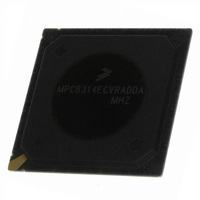MPC8314ECVRADDA Freescale Semiconductor, MPC8314ECVRADDA Datasheet - Page 97

MPC8314ECVRADDA
Manufacturer Part Number
MPC8314ECVRADDA
Description
MPU POWERQUICC II PRO 620-PBGA
Manufacturer
Freescale Semiconductor
Datasheet
1.MPC8314VRADDA.pdf
(106 pages)
Specifications of MPC8314ECVRADDA
Processor Type
MPC83xx PowerQUICC II Pro 32-Bit
Speed
266MHz
Voltage
1V
Mounting Type
Surface Mount
Package / Case
620-PBGA
Processor Series
MPC8xxx
Core
e300
Data Bus Width
32 bit
Maximum Clock Frequency
50 MHz
Maximum Operating Temperature
+ 105 C
Mounting Style
SMD/SMT
Minimum Operating Temperature
- 40 C
Lead Free Status / RoHS Status
Lead free / RoHS Compliant
Features
-
Lead Free Status / Rohs Status
Lead free / RoHS Compliant
Available stocks
Company
Part Number
Manufacturer
Quantity
Price
Company:
Part Number:
MPC8314ECVRADDA
Manufacturer:
Freescale Semiconductor
Quantity:
135
Company:
Part Number:
MPC8314ECVRADDA
Manufacturer:
Freescale Semiconductor
Quantity:
10 000
24.2
For the following sections, P
24.2.1
An estimation of the chip junction temperature, T
The junction to ambient thermal resistance is an industry standard value that provides a quick and easy
estimation of thermal performance. As a general statement, the value obtained on a single layer board is
appropriate for a tightly packed printed circuit board. The value obtained on the board with the internal
planes is usually appropriate if the board has low power dissipation and the components are well separated.
Test cases have demonstrated that errors of a factor of two (in the quantity T
24.2.2
The thermal performance of a device cannot be adequately predicted from the junction to ambient thermal
resistance. The thermal performance of any component is strongly dependent on the power dissipation of
surrounding components. In addition, the ambient temperature varies widely within the application. For
many natural convection and especially closed box applications, the board temperature at the perimeter
(edge) of the package is approximately the same as the local air temperature near the device. Specifying
the local ambient conditions explicitly as the board temperature provides a more precise description of the
local ambient conditions that determine the temperature of the device.
At a known board temperature, the junction temperature is estimated using the following equation:
When the heat loss from the package case to the air can be ignored, acceptable predictions of junction
temperature can be made. The application board should be similar to the thermal test condition: the
component is soldered to a board with internal planes.
Freescale Semiconductor
Thermal Management Information
Estimation of Junction Temperature with Junction-to-Ambient
Thermal Resistance
Estimation of Junction Temperature with Junction-to-Board
Thermal Resistance
T
where:
T
where:
MPC8314E PowerQUICC
J
J
= T
= T
T
T
R
P
T
T
R
P
A
B
A
J
J
B
θ
D
θ
D
+ (R
+ (R
JA
JB
= junction temperature (°C)
= junction temperature (°C)
= ambient temperature for the package (°C)
= board temperature at the package perimeter (°C)
= power dissipation in the package (W)
= power dissipation in the package (W)
D
= junction to ambient thermal resistance (°C/W)
= junction to board thermal resistance (°C/W) per JESD51-8
= (VDD × I
θ
θ
JA
JB
× P
× P
D
D
)
)
™
DD
II Pro Processor Hardware Specifications, Rev. 0
) + P
I/O
J
, can be obtained from the equation:
where P
I/O
is the power dissipation of the I/O drivers.
J
- T
A
) are possible.
Thermal (Preliminary)
97











